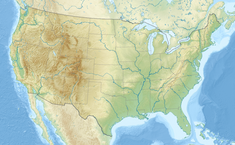
Back Arkansas Post National Memorial CEB Arkansas Post National Memorial German Puesto de Arkansas Spanish Poste Arkansas French Arkansas Post National Memorial LB
| Arkansas Post | |
|---|---|
 Partial reconstruction of the Revolutionary War era fort | |
| Nearest city | Gillett, Arkansas, U.S. |
| Coordinates | 34°01′00″N 91°20′43″W / 34.01667°N 91.34528°W |
| Area | 757.51 acres (306.55 ha) |
| Elevation | 174 ft (53 m) |
| Built | 1686 |
| Built for | Louis XIV of France |
| Restored | February 27, 1929 |
| Restored by | Arkansas General Assembly |
| Visitors | 30,126 (in 2018)[1] |
| Governing body | U.S. National Park Service |
| Website | nps |
| Official name | Arkansas Post National Memorial |
| Designated | October 15, 1966 |
| Reference no. | 66000198 |
| Designated | July 6, 1960 |
| Designated by | President Dwight D. Eisenhower |
| History of Arkansas |
|---|
 |
The Arkansas Post (French: Poste de Arkansea; Spanish: Puesto de Arkansas), formally the Arkansas Post National Memorial, was the first European settlement in the Mississippi Alluvial Plain and present-day U.S. state of Arkansas. In 1686, Henri de Tonti established it on behalf of Louis XIV of France for the purpose of trading with the Quapaw Nation.[2] The French, Spanish, and Americans, who acquired the territory in 1803 with the Louisiana Purchase, considered the site of strategic value. It was the capital of Arkansas from 1819 until 1821 when the territorial government relocated to Little Rock.
During the fur trade years, Arkansas Post was protected by a series of fortifications. The forts and associated settlements were located at three known sites and possibly a fourth. Some of the historic structures have been lost as the waterfront has been subject to erosion and flooding.[2][3] The land encompassing the second (and fourth) Arkansas Post site (Red Bluff) was designated as a state park in 1929. In 1960, about 757.51 acres (306.55 ha) of land at the site were protected as the Arkansas Post National Memorial, a National Memorial and National Historic Landmark.[4]
Since the 1950s, three archeological excavations have been conducted at Arkansas Post. Experts say the most extensive cultural resources at the site are archaeological, both for the 18th and 19th-century European-American settlements, and the earlier Quapaw villages.[3] Due to changes of the Arkansas River and its navigation measures, the local water level has risen closer to the height of the bluffs, which used to be well above the river. The site is now considered low lying. Erosion and construction of dams, canals, and locks on the Arkansas and Mississippi rivers have resulted in the remains of three of the historic forts now being underwater in the river channel.[3]
- ^ "NPS Annual Recreation Visits Report". National Park Service. Retrieved June 13, 2019.
- ^ a b DuVal, Kathleen (May 9, 2011). "Arkansas Post". Encyclopedia of Arkansas. The Butler Center. Archived from the original on April 25, 2021. Retrieved March 19, 2012.
- ^ a b c Cite error: The named reference
nrhpinvwas invoked but never defined (see the help page). - ^ "Listing of acreage – December 31, 2011" (XLSX). Land Resource Division, National Park Service. Retrieved March 30, 2012. (National Park Service Acreage Reports)
© MMXXIII Rich X Search. We shall prevail. All rights reserved. Rich X Search
